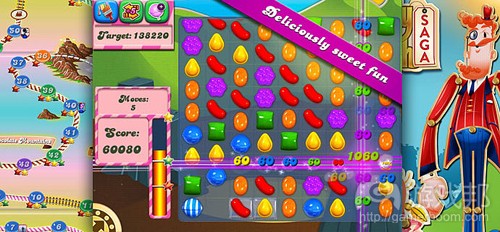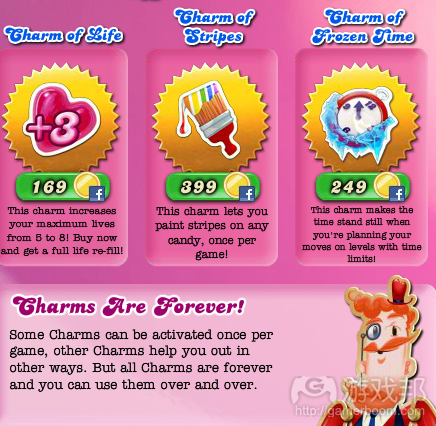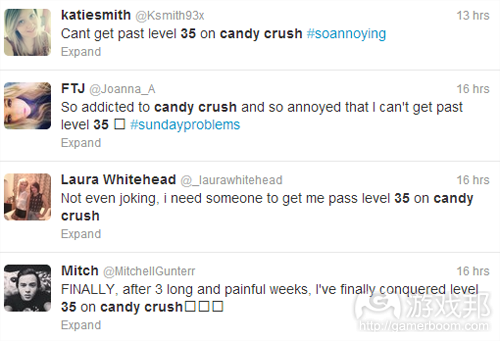解析《Candy Crush Saga》的成功设计特点
作者:Tami Baribea
自最后一款人人都在玩的iOS/Facebook游戏——Zynga的《Draw Something》发布已经过去一年了。风水轮流转,现在你妈妈在玩的、你本人绝对也在玩的、你叫你的朋友去玩的游戏是King.com的《Candy Crush Saga》。这款匹配消除游戏在iOS App Store收益排行榜名列前茅,也是Facebook上日/月活跃用户最多的应用,还在Google Play的十大免费应用中名列第一。
是什么让这款与《Bejeweled》非常神似的游戏这么成功?为什么人人都爱玩(花钱)这款“多款游戏杂交的克隆游戏”?
《Candy Crush Saga》是精致的
King.com里一定有人非常重视《Candy Crush Saga》的细节,所以才能做出这么鲜明的色彩搭配,这么直观简洁的UI,这么流畅的教程。这款游戏的玩法非常简单,几乎所有人都能在第一眼就看出怎么玩。游戏中没有任何一个地方让人觉得“粗糙”——每一个元素都是精心设计和制作的,让玩家在每一个操作中都感到快乐和兴奋。虽然《Bejeweled》也是非常精致的游戏,但它缺少一种让人觉得新鲜而现代的主题。
《Candy Crush Saga》以糖果为主题元素,使游戏得以围绕糖果展开轻松的故事。在各个“章节”之间,都有一个小过场动画叙述糖果居民的故事。色彩丰富的糖果和道具非常吸引眼球。声音鼓励(当玩家消除匹配组时,游戏会说一些赞美鼓励的话)让玩家觉得可爱又好玩。欢快而舒服的音乐使你沉浸于游戏世界,忘记游戏AI正在积极地“谋划”如何让你失败。每一次按下按按钮、滚动和轻敲,游戏都会发出声音提醒,这其实是对玩家行为做出必要的反馈,即使他们通常不会意识到。
《Candy Crush Saga》是困难的
如果你玩《Candy Crush Saga》到15级,那么你肯定咒骂过它和它的开发者。忠实的益智游戏玩家偶然尝试游戏时,可能会觉得它不过是一款简单、模仿痕迹严重的游戏,我第一次玩时也是这么觉得。一位同事告诉我,我必须玩到至少10级才能真正体验到《Candy Crush Saga》的精髓。结果,我一发不可收拾,完全沦为《Candy Crush Saga》的信徒。这款游戏确实不简单。
与PopCap的《Bejeweled Blitz》那种让玩家在一定时间内打败朋友,挤上排行榜的游戏不同,《Candy Crush Saga》有真正的失败情况(这在社交游戏中是极少见的)。玩家卡在游戏的某个关卡里好几天,并非少见,但开发者对难度把握得恰到好处,玩家不会因为反复失败而觉得受挫,甚至彻底离开游戏,而是坚持不懈地玩下去。与《愤怒的小鸟》类似,玩家通常能淡定地接受失败。虽然失败不可避免且常常发生,但玩家不会因此讨厌并认为《Candy Crush Saga》不够休闲。总之,《Candy Crush Saga》足够让老手和狂热的益智游戏玩家着迷,也满足了普通玩家的娱乐需要。因为它的难度,玩家在网上发表各个关卡的通关流程和技巧。因为游戏不计时,所以玩家有足够的时间仔细考虑每一步,这就让玩家感受到在其他游戏中体会不到的技术感。
如果社交游戏领域存在一个奥斯卡奖,《Candy Crush Saga》应该获得免费游戏中的“最佳关卡设计奖”。
玩家永远不必担心接下来要做什么
将“生命”系统(游戏邦注:限制玩家一次登录的游戏次数)和可能失败的明确目标(如得到所有水果或清除所有果冻)相结合,意味着玩家总是意犹未尽地退出游戏,并且认真计划下次登录要完成什么目标。《Candy Crush Saga》永远不会让玩家闲着没事干。许多社交游戏为了防止玩家无所事事,提供一系列“任务”以便引导玩家去完成下一个目标,但这种强迫又不自然的方式只会刺激玩家在游戏中花更多时间。《Candy Crush Saga》是线性的,但玩家乐意跟着这条预设的路径走。
丰富多样的目标
《Candy Crush Saga》虽然属于“匹配消除”类游戏,但又突破了这个类型。正如King.com问他们自己:“这个世界已经有《Bejeweled》了,那么我们要做什么呢?”匹配3颗糖果可以消除它们并得分,匹配4颗糖果可以得到1颗特殊的糖果(它可以水平或垂直清除整行,方向取决于匹配组的方向),匹配5颗糖果可以消除四周大片范围内(取决于匹配组的正式形状,可以是T型、L型或线段)的同色糖果。混合那些特殊的糖果可以引发其他特殊效果。各个关卡都要完成特定的目标,才能进展到下一关。目标如清除所有“方形果冻”、移除甘草、击落各种随机下落的水果、用阻止巧克力扩散,等等。
虽然玩家在《Candy Crush Saga》可能用得分与朋友竞争(使游戏具有更高的重玩价值),但得分不是主要目标。游戏明智地提供了相当丰富的目标,同时不改变游戏的规则。无论某个关卡的目标是什么,玩家总是能用各种各样的组合方式消除糖果。玩家总是能借助熟悉的情境,总是能想出对付某个关卡的策略。我总是迫不及待地想知道下一个目标是什么,随着关卡目标的变化,游戏节奏也在变化,但并不要求我学习新的系统。而像《Bejeweled Blitz》这类游戏,每一次都是一样的——虽然宝石的布置可能每一次都不同,但目标总是在给定的时间内获得尽可能多的得分。如果《Candy Crush Saga》的200多个关卡目标都是一样的,那么这款游戏就会非常无聊。
定期更新的关卡
从玩家第一次玩《Candy Crush Saga》开始,他们滚动游戏的地图时会发现这款游戏提供了245个关卡(注:这是本文撰稿为止,King.com定期推出新关卡)。这就给玩家带来一种参与宏大工程的感觉。现实世界的朋友的微笑头像分布在路径上,似乎是邀请玩家展开欢乐的冒险。这条路径其实就是之前提到的线性路径,玩家从中可以看出游戏有非常丰富和稳定的内容流等着他们去挖掘。所有这一切都使这款游戏更加吸引玩家。
真正的社交性
说到社交游戏,《Candy Crush Saga》可以说是命中所有热词:它具有极强的病毒传播力,通过与社交网络巨头Facebook联手、要求玩家互相帮助,游戏形成非常深刻而宽广的社交互动网络。《Candy Crush Saga》真正地通过朋友互动强化游戏体验本身,这与某些利用它作为纯粹的推广游戏的工具是不一样的。
朋友互相帮助通关这种强调技术的游戏的方法是,赠送道具和额外的回合,当玩家“生命”用尽,继续玩下去的唯一方法除了花钱就是请朋友赠送额外的“生命”。这个机制当然算不上新鲜——自Facebook病毒传播力成为产品的一个不成则败的概念后,许多游戏都是围绕它展开设计的。然而,《Candy Crush Saga》还利用好友作为增加各个关卡得分和进展整体游戏的刺激物,即把好友头像显示在地图上,告诉玩家自己的得分情况与这些好友的关系。
在《Candy Crush Saga》中,玩家同时进行好友合作、互相帮助和互相竞争。Facebook整合不是对游戏的补充;《Candy Crush Saga》原本就是以好友互动作为玩法机制,并且它成功了。因此,当开发者们谈论“增加社交性”作为发布版的资料片,我觉得不安。这就像做免费游戏时居然没有考虑它的商业模式。King.com通过提供这种社交满足感,刺激玩家继续玩下去。
占领热门平台
《Candy Crush Saga》已经占领了许多免费游戏兴起的最热门平台。这款游戏打败所有Zynga的游戏,成为Facebook上的人气王。在2012年9月,《Candy Crush Saga》在iOS App Store和Google Play上发布,只用了两周时间就打入iPhone应用收益排行榜前20名,并且仍有上升的势头。登录Google Play一个月后,《Candy Crush Saga》成为收益排行榜上的冠军,并且一直霸占着宝座。iPad版也表现不俗。
更重要的是,只要连接到玩家的Facebook帐号,游戏就可以在所有设备上完全无缝地同步。比如说,玩家可以在上班时登录Facebook,然后在午休时用iPhone玩,晚上睡觉前再用iPad或Nexus平板玩。这是一个非常流畅而自然的过程,King.com保证你时时想着《Candy Crush Saga》,并且手边总是有一部能玩它的设备。
美中不足
作为一名免费游戏开发者,我认为《Candy Crush Saga》简直就是一款完美的社交游戏。我感谢它把我当成成年人,给我合适的挑战。我想赞美它精致的关卡、画面和氛围。然而,如果不谈谈它的美中不足之处,我的这篇文章就无法完整了。
我对这款游戏最大的抱怨在于,这款游戏对资源和增益道具太小气、对某些奢侈品收费过高。每一条额外生命是99美分。每一种增益道具是0.99-1.99美元。条纹特效是39.99美元(但购买后可以在所有关卡中使用)。游戏一开始限制玩家购买这些道具,除非玩家随着进度解锁它们,这就给玩家一种错觉,好像解锁就能免费获得似的;事实上解锁的只是花钱购买这些道具的能力。
《Candy Crush Saga》还故意限制进程,即要求玩家向他们的好友索取“门票”或花钱购买下一个关卡的章节。除了生命数和自己的能力,因为玩家们并不觉得自己的游戏进程还受到其他东西的限制,这让我感到惊讶。某些玩家可能会在这个时候选择放弃《Candy Crush Saga》而选择玩其他游戏。有些人就是不愿意求助于Facebook好友。对于另一些人,这不是大问题,因为游戏在此之前都是免费的,而且之前享受到的乐趣值得花0.99美元继续下去。
最后,到某些级别(其实就是第35级)的时候,我们可以看出开发者有意让玩家的技能不足以通关,从而刺激他们使用可购买的道具。这样设计关卡一方面增加了游戏的收益(所以《Candy Crush Saga》才能占领收益排行榜的宝座),另一方面不会让玩家觉得自己被游戏欺骗。这些关卡通常困住玩家好几天,使他们满心希望他们下一次行动会恰好产生能帮他们通关的糖果。这是我觉得《Candy Crush Saga》与《Bejeweled Blitz》唯一接近的地方——在达到目标的过程中,运气的份量大过技术。(本文为游戏邦/gamerboom.com编译,拒绝任何不保留版权的转载,如需转载请联系:游戏邦)
Why Candy Crush Saga is taking over the world
by Tami Baribea
It’s been over a year since a casual game has released on iOS and Facebook that just about everyone is playing—-the last was OMGPOP/Zynga’s Draw Something. A game that your mom is playing, you are absolutely playing, you’re telling other people to play. King.com’s Candy Crush Saga is seemingly everywhere today: It’s Top Grossing in the iOS App Store, it’s the biggest app on Facebook in terms of daily and monthly traffic, and this match-3 puzzler is also in the top 10 free apps in Android’s Google Play store.
What is it that makes this spiritual successor to Bejeweled so successful? Why are people playing (and paying) for Candy Crush Saga, a game that looks to be an unoriginal clone of many other games?
Candy Crush Saga is extremely polished
From top to bottom, someone at King.com has given a lot of love and attention to detail to Candy Crush Saga. The colors are bright and inviting, the user interface is intuitive and not complicated at all, the tutorial experience is slick and the gameplay is simple and familiar enough that almost everyone can understand how to play from the moment they begin. There is not a single part of the game that feels ‘cheap’—-every element of Candy Crush Saga is carefully constructed to make the player feel joy and excitement with each action. While Bejeweled is also extremely polished, it lacks a light and fun theme that makes it feel fresh and modern.
The candy-coated nature of Candy Crush Saga allows for King.com to have some lighthearted fun with it. In between ‘chapters’, little cut-scenes are shown that offer up a lightweight story about helping out the candy inhabitants. The candy pieces and the boosts themselves are colorful and appealing to look at. The verbal encouragements (voice-overs that occur when the player matches candy gems in more interesting combinations) are dripping with sweetness , such as “Sugar Rush!” and “Tasty!”. The music is happy and soothing, and lulls you into a false sense of security that the game’s AI isn’t actively trying to make you lose. There are sound effects on every button click, scroll, and tap which gives the affirming feedback that every player needs but doesn’t know it.
Despite its first impression, Candy Crush Saga is a challenging game
If you’ve played Candy Crush Saga above level 15, there is a near 100% chance that you have sworn at it, cursed the developers, and felt as if life isn’t fair. An avid puzzle gamer casually trying the game out might feel that it is simple and unoriginal, a feeling that I had during my first encounter with the title. A coworker told me that I had to reach at least level 10 to truly experience Candy Crush Saga and all of its glory, which ended up being the silver bullet that I needed to sacrifice my self-discipline and give myself fully to Candy Crush. This game is no joke.
Where a game like PopCap’s Bejeweled Blitz offers up a randomized experience where the player is given a set amount amount of time to beat their friends on a leaderboard, Candy Crush Saga has a true lose condition (something that is rare in social games). It is not uncommon for a player to be stuck on a level for days, a situation that ends up being just difficult enough to keep the players trying yet not a ‘shelf moment’ where the player quits playing out of dire frustration. Similar to Angry Birds, it’s okay to fail. It’s not the point to fail, it’s not the end goal, but it will happen and it’s not going to make players hate the game or make Candy Crush any less casual. The constant challenge will retain experienced gamers and puzzle game aficionados, and the ease of rebounding after failure will keep players of all ages entertained. Candy Crush Saga is difficult enough that entire blogs exist to host video walkthroughs of each level and tips and tricks for beating the game. Since time is not a factor in the game, players have time to think about each move which adds a sense of skill that other games do not possess.
If social games had an Academy Awards, Candy Crush Saga would deserve an Oscar for “Best Level Design in a Freemium Game”.
Players are never concerned about what to do next
A combination of the ‘lives’ system (which limits the number of attempts within a session) and the fact that there is a clear objective which can be failed (such as getting all the fruits to the bottom or clearing all the jellies) means that a player ends their session wanting more and having a clear plan of action for the next time they open the app. Candy Crush Saga never has a moment where the player doesn’t know what to do next. Many other social games solve this conundrum by providing the player with a detailed list of ‘quests’ that guide them to the next objective, but this is a forced and unnatural way to motivate players to spend more time in a game. Candy Crush Saga is as linear as a game can get and our minds enjoy having a preset path to follow.
Objectives offer variety that puzzle games often lack
Candy Crush Saga takes the ‘match-3′ puzzle genre and adds a layer of excitement on top as if King.com said to themselves, “the world already has Bejeweled; so what do we do next?”. Matching 3 candies in a row simply offers points and clears the gems from the board, 4 gives a special candy that can clear entire rows (either horizontal or vertical depending in which direction the match was made), 5 gives the player a candy that will either destroy a wide region around it or remove all candies of a particular color from the board depending if they were matched in a T-shape, L-shape, or a line. Mixing those special candies together causes other surprising things to happen. Each level has a particular objective that has to be completed to progress to the next level. Some of these objectives include clearing all ‘jelly squares’ from the board, removing licorice from locked candies, bringing down various fruits which randomly appear on the board, and preventing chocolate from spreading.
While Candy Crush Saga might offer points as way to compare score with friends (and give the game an element of replayability), points aren’t the primary objective. The game can cleverly offer a nice variety of objectives without altering the game’s rules. No matter the objective for a given level, players will always be matching candies in various combinations and trying to clear the board. Players always have the familiar context to rely on, and they always know how to get started on figuring out the strategy for a particular level. I am always looking forward to what the next objective will be, and find it a pleasing change of pace when my ultimate goal is changing from level to level without requiring me to learn new systems. A game like Bejeweled Blitz is the same every time?—?while the placement of the gems on the game board might change each time, the goal is always to get the highest score possible within the time allowed. 200+ levels of that formula in Candy Crush would grow tiresome.
There’s a long road full of levels ahead of players
From the first time a player starts up Candy Crush Saga, they can scroll up and down the Candyland-esque map and see that the game offers 245 levels of play (note: that’s of this writing?—?King.com are regularly increasing the level cap). This gives players an aspiration and a sense of being involved in something grandiose. The addition of real-life friends’ smiling faces poised with triumph along this path shows players that Candy Crush offers an adventure that people they respect are enjoying (so maybe they will too). It alludes to that linear pathway mentioned earlier and shows the player that this game has decent longevity and a steady stream of content for them to digest. All of these things assist in making the game appealing to players as a lightweight and fun experience yet an investment that can potentially give back to the player through interaction with friends within the game.
Inherently social: is this the ‘true social’ we speak of?
Candy Crush Saga hits all the buzzwords when it comes to being a social game: it’s viral in nature, retains its players, offers up deeper social interactions that investors love to hear about, is integrated with the social network behemoth Facebook, and literally requires friends to help each other to progress. Having friends is actually an enhancement to the play experience in every way in Candy Crush, whereas in some social games it feels as a selfish ploy to spread word about the game.
Friends assist each other with progressing through this skill-based game by offering boosts and extra turns; advantages that truly make Candy Crush Saga better when possessed. After running out of lives, the only way to continue playing aside from spending money is to ask friends to offer additional lives. This mechanic certainly isn’t new?—?viral games have been literally designed around this since Facebook virality became a make-or-break concept for products. However, Candy Crush Saga also uses friends as a motivator for increasing score on each level and progression throughout the overall game by showing their position on the map and telling players how they scored in relation to them.
In Candy Crush Saga, players are simultaneously cooperating with friends, helping each other out, and competing against each other. Facebook integration isn’t something tacked on to the game; Candy Crush was designed to use friends as a gameplay mechanic and it works. For this reason, when developers talk about ‘adding social’ as a feature set post-launch, I want to cringe. It’s like building an entire freemium game without thinking about the business model. King.com molded social motivators with individual gratification perfectly.
Candy Crush Saga is available everywhere
Finally, I’d be a fool to skip over the fact that Candy Crush Saga is available in the hottest places that free-to-play games flourish. The Facebook app was the original incarnation and is currently beating all Zynga titles as the most popular game on Facebook. In November 2012, Candy Crush Saga was released on the iOS App Store and Android’s Google Play store. It took under 2 weeks for the app to make the top 20 Top Grossing iPhone apps list and it hasn’t gone below that since. After one month on Google Play, Candy Crush Saga hit the number 1 Top Grossing list and hasn’t let go since. The iPad version looks glorious on the larger screen size.
Even more importantly, one connection to the player’s Facebook account and the game is synchronized across all devices completely seamlessly. Someone can log in on Facebook while at work, then play on their iPhone on the toilet, and then load up Candy Crush Saga on their iPad or Nexus Tablet while in bed at night. It’s smooth as butter, and King.com are making sure that you’re thinking about Candy Crush wherever you might be and that you’re never far from a device that can play it.
Candy Crush Saga is not a game without complaints
The freemium game developer in me wants to put Candy Crush Saga on a pedestal and claim it to be the perfect social game. I want to appreciate that it treats me like an adult and gives me welcome challenges. I want to unabashedly praise it’s beautiful level of polish, look, and feel. However, I can’t close this article without discussing briefly the complaints that many players have about the game.
The largest complaints exist around the fact that the game is stingy with resources and boosts and charges an astronomical amount for some of these luxuries. Every additional purchased life is 99 cents. Each boost costs $0.99 – $1.99 each. A Charm of Stripes boost costs the player $39.99 (but is a one-time purchase that can be used in every level after its unlocked). The game withholds the ability to purchase these boosts at first and ‘unlocks’ them as the player progresses, giving the illusion that they will be free when in fact the only thing that unlocked was the ability to spend money on those boosts.
Candy Crush Saga also artificially gates progression by requiring players to get tickets from their friends or pay money to unlock the next chapter of levels. This comes as a sort of surprise because it’s not evident to players that they will be gated from progression in the game by anything aside from lives and their own skill. For some players, this is the moment where they opt to put Candy Crush aside and move on to something new. Some people simply aren’t willing to beg Facebook friends for anything game related. For others, this isn’t a major issue because the game is free up until this point and the amount of entertainment enjoyed prior is worthy of the $0.99 to progress.
Finally, it becomes transparent in some levels (read: level 35) that the developers are designing with the intent that skill won’t be sufficient to pass a particular level and that purchasable boosts will need to be used. This is the brilliant level design that is both leading to Candy Crush Saga dominating all the top grossing charts and insulting players who feel that the game is manipulating them by ‘cheating’. These levels often cause players to be stuck for days hoping that their next attempt will result in the random distribution of candies working out in their lucky favor. This is the only element of Candy Crush Saga that feels closer to Bejeweled Blitz?—?when luck outweighs skill in obtaining an objective.(source:medium)
下一篇:阐述时间因素对人们制定决策的影响












































 闽公网安备35020302001549号
闽公网安备35020302001549号